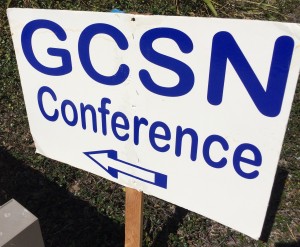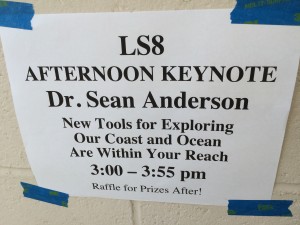Teaching Teachers
A fun conference
 Our AARR Team was graciously invited to be a part of this year’s annual conference for the Gold Coast Science Network. This professional society for K-12 educators across our region of southern California draws their members from a area roughly bounded by San Luis Obispo County in the north, Orange County in the south, and inland as far as Kern County and the Inland Empire. In existence since the mid 1990’s, this year marked their 11th annual conference showcasing talks about the most recent approaches to imparting scientific discovery melded with dozens and dozens of practical teaching demos/hands-on lab development charrettes.
Our AARR Team was graciously invited to be a part of this year’s annual conference for the Gold Coast Science Network. This professional society for K-12 educators across our region of southern California draws their members from a area roughly bounded by San Luis Obispo County in the north, Orange County in the south, and inland as far as Kern County and the Inland Empire. In existence since the mid 1990’s, this year marked their 11th annual conference showcasing talks about the most recent approaches to imparting scientific discovery melded with dozens and dozens of practical teaching demos/hands-on lab development charrettes.

Showcasing AARR Robots

Students from our AARR lab group were a hit at our demonstration table where we showed off a few of our aerial and aquatic robots we use for research and teaching. Forrest, Tim, and Chase did a fantastic job of showcasing our work and units while fielding any number of questions about the technology and how we use it to engage learners.
Plenary on Conservation Mechatronics
 After a day of demoing and discussing all manner of robots and methods to captivate students with science, Dr. Anderson gave the closing plenary to a super packed auditorium with his typical, highly energetic zeal. It was the end of the day and a bit warm in the room, but those teachers were truly anxious to hear about all the great stuff we have managed to cook up at CSU Channel Islands over the last few years.
After a day of demoing and discussing all manner of robots and methods to captivate students with science, Dr. Anderson gave the closing plenary to a super packed auditorium with his typical, highly energetic zeal. It was the end of the day and a bit warm in the room, but those teachers were truly anxious to hear about all the great stuff we have managed to cook up at CSU Channel Islands over the last few years.
Screencast of Dr. Anderson’s plenary:
Dr. Anderson’s slides are free to download (via Research Gate) here.
Dr. Anderson’s Plenary Abstract:
A literal and figurative sea change is all about us. As our water world is facing unprecedented assaults from our burgeoning human population, a new panoply of tools is falling into our hands to help us better understand those changes. These tools offer us an unprecedented opportunity to explore our oceans with a precision and scope heretofore restricted to only the most cutting edge research institutions. Our Aerial and Aquatic Robotic Research (“AARR”) Group at CSU Channel Islands has brought key capabilities to our on-going interdisciplinary coastal investigations. Only in the last few years have we been able to take advantage of affordable, miniaturized electronics ushered in by the smart phone revolution. Cheap, power sipping computer chips are melding with ever smaller, lighter batteries, 3D printing, and the open source movement to put the ability to explore our marine environment into nearly everyone’s hands. Where half a million dollars used to buy you a so-so underwater Remotely Operated Vehicle, we can now build something quite similar or even more capable for $800. CSU Channel Islands is fast becoming the go to location for such innovation. We are training everyone from our undergrads to local middle schoolers to design, build, service, operate, and collect robust data with these tools. We will discuss our efforts, ideas for how you might get going, some of the new insights we are gaining by having these new capabilities, and demo some of our platforms.
More Videos
Links to our videos Dr. Anderson mentioned in his talks that may be of interest to you or your students:
An example 3D map
We created this from a single, 15 minute drone flight using photo stitching software. Note: this will run in any browser using your mouse to navigate, hold down your control or option key while using your mouse to zoom in or out.
Behavioral ecology of humpback whales in the Maui Channel
This is from January of 2016. You can also watch a local news story about Dr. Cartright’s work here.
Cooks Islands 2015
Student video from our 2015 Service Learning class trip to the Cook Islands showcasing our flying and swimming robots:
We ran out of time to show all our videos, but a few of these illustrate points or projects Dr. Anderson mentioned and may be of interest:
Merging Performing Arts and Science
Dudleya Restoration
Restoration ecology experiments (see all them here) to recover the endangered plant Dudleya verity:
The Nature Conservancy’s Drones and Phones Project
CBS LA Story from February 2016.
Note: The Nature Conservancy just visited our campus two weeks ago and gave a departmental seminar about their more general coastal conservation work. You can watch that video here.
Training & Educational Resources from Pirate Lab
While beyond much of the K-12 level, if you are interested in learning more about our UAV curriculum, you can freely watch most of our class lectures, explore our robotic news curation site (this might be a great source for student research), or poke around our introductory class blog. A recent post on the first-ever drone educator conference we attended several weeks ago may also be of interest.
Drone Poll
Lastly, Dr. Anderson mentioned we have just taken our annual UAV public opinion poll live as of this weekend. If you have a few moments, please consider taking this poll and passing it along to your networks. It will be open for about six weeks and it totally anonymous.
2016 CSUCI UAV Poll
https://csuci.qualtrics.com/SE/?SID=SV_0jkUzTeKGnslZ2Z
Thanks again for all the great questions and kind words at the conference. We support tons of efforts at middle, high school, and local colleges and are always open to discussions and collaboration (we just tend to be a bit overscheduled and overcommitted…especially Dr. A). Please let us know how we might be able to help you in your teaching efforts with a class presentation, an invite for your class to tour our lab, etc.
